Cycling, Cycle Touring and Mountain Biking Good Practice Guide
Guidance for learning to cycle, cycling, cycle touring and mountain biking.
Version 1.0 | Date 23 Sept 2019 | Details: Version one release.
Acknowledgment, disclaimer and preface
Acknowledgment, disclaimer and preface
Traditional owner acknowledgement
The Outdoor Council of Australia and the Australian AAS Steering Committee would respectfully like to acknowledge the Traditional Owners, their Elders past, present and emerging, for the important role Indigenous people continue to play in Australia and most especially on the land and waters used for outdoor activities and recreation.
Disclaimer
Copyright
Copyright 2019 Outdoor Council of Australia.
Disclaimer
The information published in the Australian Adventure Activity Standard (AAAS) and accompanying Good Practice Guides (GPG’s), including this document, is for information purposes only and is not a substitute for, or intended to replace, independent, professional or legal advice. The information contained in the Australian Adventure Activity Standard and the Good Practice Guides are a guide only. Activity providers and any other person accessing the documentation should consider the need to obtain any appropriate professional advice relevant to their own particular circumstances, including the specific adventure activities and needs of the dependent participants.
The information published in the Australian Adventure Activity Standard and Good Practice Guides are subject to change from time to time. Outdoor Council of Australia gives no warranty that the information is current, correct or complete and is not a definitive statement of procedures. Outdoor Council of Australia reserves the right to vary the content of the Australian Adventure Activity Standard and/or Good Practice Guides as and when required. Activity providers should make independent inquiries as to the correctness and currency of the content and use their own skill and care with respect to their use of the information.
The Australian Adventure Activity Standard and Good Practice Guides do not replace any statutory requirements under any relevant State and Territory legislation and are made available on the express condition that Outdoor Council of Australia together with the authors, consultants, advisers and the Australian Adventure Activity Standard Steering Committee members who assisted in compiling, drafting and ratifying the documents:
- are not providing professional or legal advice to any person or organisation; and
- are not liable for any loss resulting from an action taken or reliance made on any information or material contained within the Australian Adventure Activity Standard, Good Practice Guides and associated documents.
Preface
Forward
“Adventure is worthwhile” – Aristotle
The Australian Adventure Activity Standard and Good Practice Guides are designed to ensure effective, responsible, sustainable and safe delivery of adventure activities to dependent participants. They can help people across the outdoor sector to develop appropriately managed adventure activities which enhance individuals and our communities, while protecting the environment and culturally significant places. In doing this, these documents can help ensure that people will continue to enjoy the benefits of adventure activities well into the future.
Best wishes for all your adventures.
The Australian Adventure Activity Standard Steering Committee.
About these documents
The Australian Adventure Activity Standard (AAAS) and related Good Practice Guides (GPG’s) are a voluntary good-practice framework for safe and responsible planning and delivery of outdoor adventure activities with dependent participants.
The AAAS and related GPG’s provide guidance on safety and other aspects of responsible activity delivery, such as respect for the environment, cultural heritage and other users. They are not a full legal compliance guide, nor are they a “how to” guide or field manual for outdoor activities. They do not provide guidance on providing a high-quality experience over and above safe and responsible delivery.
Activity providers are encouraged to obtain independent professional and legal advice in relation to their obligations and duties in delivering adventure activities and should reference the relevant laws to the area in which they intend to undertake the adventure activity.
Does the Standard and Good Practice Guides apply to me?
The AAAS and related GPG’s are specifically designed to help activity providers who are conducting activities involving dependent participants, to provide a safe and responsible experience. It is for each provider to determine based on their own individual circumstances, if they are working with dependent participants or not.
A dependent participant is a person owed a duty of care by the activity provider who is reliant upon the activity leaders for supervision, guidance or instruction to support the person’s participation in an activity. For example, this often includes participants under the age of 18, participants lacking the ability to safely undertake the activity, or participants reasonably relying on the activity provider for their safety. The degree of dependence may vary during an activity.
Considerations for determining if a person is a dependent participant may include, but is not limited to:
- the foreseeable level of competence of the participant in the activity and the associated level of reliance this creates on the activity leaders
- the level of foreseeable self-reliance of the participant to reasonably manage their own safety
- the possible variation throughout the activity of the level of reliance
- the variation of the degree of dependence throughout the activity
- the individual context, nature and circumstances of the activity
- the relevant circumstances and particular facts relating to the responsibilities assumed by the provider.
An activity provider can be any organisation – business, community group, government agency, school or any other groups – that organises and leads adventure activities. Individuals can also be an activity provider, if they have the ultimate legal duty of care to participants. In general, ‘the Standard’ and GPG’s relate to a provider as a ‘whole organisation’, rather than to ‘specific roles’ within the provider ‘organisation’.
Some providers may have their own standards or guidelines appropriate to their duty of care. It is recommended that these be reviewed periodically to ensure current duty of care expectations are met. ‘The Standard’ and ‘GPG’s’ may aid such reviews.
Are they legally binding?
The AAAS and GPG’s are voluntary, not legal requirements. However, they may refer to specific laws and regulations which may be legally binding on activity providers.
While the AAAS and ‘GPG’s’ are voluntary, some land managers and other organisations may require compliance. This may be as a condition of obtaining a licence, permit or other permission, or some other condition (e.g. a contract).
Under Australian common law and relevant legislation, providers have a legal duty of care towards dependent participants in some circumstances. In broad terms, the legal duty requires providers to take reasonable care that their actions and omissions do not cause reasonably foreseeable injury to dependent participants.
The AAAS and GPG’s are not legal advice, and they cannot answer whether a legal duty exists in specific circumstances. All adventure activity providers should check what legal requirements apply in their own situation and seek legal advice if at all in doubt.
Even in cases where participants are not dependent, other legal duties and obligations may arise. The AAAS and GPG’s have not been developed for those contexts.
Structure of the Standard and Good Practice Guides
The AAAS (i.e. the Standard) has a related Core Good Practice Guide (Core GPG). They both include guidance that applies to all adventure activities. They set out recommendations for a common approach to risk management that can generally apply regardless of the specific activity being undertaken.
Individual activity Good Practice Guides include guidance on specific adventure activities.

For any given activity, (i) the AAAS (the Standard), (ii) the Core GPG and (iii) the activity Good Practice Guide that applies to that specific activity, should be consulted.
The AAAS and Core GPG cover only those activities specifically listed. While the AAAS and Core GPG may be useful in managing risk generally for other activities, they may not reflect good practice for such other activities.
Interpretation of the Standard and Good Practice Guides
The following words and phrases are used in all documents and have specific meanings:
- Must: used where a provision is mandatory, if the provider is to operate fully in accordance with AAAS or GPG’s. (This is equivalent to the keyword “shall” used in other voluntary standards e.g. Standards Australia, other International Standards Organisations (ISO’s) etc.)
- Should: used where a provision is recommended, not mandatory. It indicates that the provider needs to consider their specific situation and decide for themselves whether it applies or is relevant.
- Can/cannot: indicates a possibility and capability.
- May/need not: indicates a permission or existence of an option.
- But are/is not limited to: used to indicate that a list is not definitive and additional items may need to be considered depending on the context.
The following formatting is used throughout:
- Defined words are in italics. They are defined in the Glossary.
- Examples are in smaller italic 9-point font.
- In document references are in underlined. References are to section heading titles.
- External web or Australian AAS & GPG document links are in dotted underline italic.
Creation
The AAAS and GPG’s were developed with the input from a wide range of outdoors and adventure activity experts with extensive field experience. They draw on state and territory-specific standards previously in place across Australia. The development process included work by a range of technical expert working groups, as well as open consultation throughout the community of activity providers and other experts.
The Steering Committee wishes to thank all the Technical Working Group (TWG) members for their work and contributions.
The Steering Committee acknowledges all the State and Territory Governments for funding the creation of the first national adventure activity standard and set of good practice guides for the sector.
Further details of the creation of the AAAS and GPG’s can be found at australianaas.org.au/about/history/
It is intended that the AAAS and GPG’s will be regularly updated to reflect changing practice and better understanding over time. Updates will be noted on the website www.australianaas.org.
1 Introduction
1.1 Cycling activities
Cycling is riding a cycle which requires rider effort to power movement. A cycle may be a bicycle, unicycle, tri-cycle, quad-cycle or pedelec. Cycling can occur for a range of reasons on a variety of terrain. It can occur for time periods ranging from minutes to journeys over many days. For the purposes of this Good Practice Guide, it relates to cycling with dependent participants.
Cycling may include learning to ride, rider skill development, undertaking a journey (cycle touring), journeying overnight or for extended periods of time and completing challenging obstacles (mountain biking). It could involve riding on roads, cycle-paths, trails or off-road.
Mountain Biking is riding a cycle ‘off-road’ with a major element being the need to negotiate obstacles. It usually occurs on unsealed surfaces, such as trails, single trails, open or rocky ground, and involves manoeuvring through or around obstacles such as fallen or narrowly spaced trees, creeks, mud, rocks, man-made structures, jumps and other technical features. Due to the type of terrain and obstacles to negotiate, the skills and cycle design required to mountain bike can differ to other forms of cycling.
1.2 Exclusions
Activities that are not covered by this Good Practice Guide (GPG) are:
- cycling in competitive events
- coaching for competitive events
- the use of motorcycles
- the use of e-bikes
- BMX freestyle or stunt riding
- the design and/or construction of roads, cycle-paths or trails
- activities associated with camping while on overnight or extended mountain biking or cycle touring activities.
1.3 Related activities
Related activities are:
Camping when undertaking overnight or extended activities.
Refer separate Core GPG for Camping.
2 Management of risk
Refer to the Core Good Practice Guide – Management of risk.
There are no additional specific activity provisions other than Core GPG – Management of Risk provisions.
3 Planning
Also refer Core GPG – Planning.
3.1 Activity plans
Specific planning considerations may include but are not limited to:
- the expected or known trail classification
- the impact of current seasonal factors including the weather forecast for the day(s) of the activity and weather during recent days
- identifying route and terrain specific hazards and risks
- the need for a support vehicle(s)
- the required navigation skills & equipment
- the suitability of maps for navigation
- the access available for support and emergency services for the start and finish locations and throughout the activity
- if passengers can be carried and the most appropriate means of doing so.
3.2 Emergency management planning
A non-participating contact must be used as part of the emergency management plan.
4 Participants
4.1 Pre-activity information
Also refer pre-activity information in Core GPG.
Pre-activity information provided to participants should include but is not limited to:
- the level of fitness required for the activity
- the required level of skills and knowledge for the activity
- expected type of gradient and obstacles.
4.2 Participant skill assessment
Participants must undertake a skill assessment to confirm the appropriateness of the activity for the participant.
The participant skill assessment may include but is not limited to:
- ability
- experience
- fitness level.
Skill assessments for Mountain Biking should identify the IMBA Australian Trail Difficulty Rating suitable for the participant.
4.3 Carrying passengers
Requirements for passenger(s) being carried must include:
- the person towing the trailer meets any laws, regulations or requirements for the relevant jurisdiction(s) (e.g. age requirements)
- the person towing or carrying passengers is a competent rider
- the passenger(s) in the trailer meets any laws, regulations or requirements for the relevant jurisdiction(s) (e.g. age, disability or medical condition requirements).
5 Environment
5.1 Environment related planning
Specific environmental considerations must include:
- the road, cycle-path, off-road or trail features
- other users
- climate or weather
- the type of flora expected
- the type of fauna expected.
Cycle environment features that must be used to determine a participant’s skill assessment (see participant section above) include:
- the gradient
- the surface
- the width
- the obstacles to be negotiated.
Strategies to reduce the hazards and risks associated with other vehicular, cycle or pedestrian traffic must be used.
5.1.1 Weather information
Refer Appendix 3 Weather information.
5.1.2 Weather triggers
Trigger points must be based on the relevant Bureau of Meteorology weather warnings and actual weather conditions.
The risk management plan and emergency management plan should include guidance on trigger points and associated actions for:
- severe weather warnings
- severe thunderstorm warnings
- coastal waters wind warnings
- tropical cyclone advice: watch and warning
- cold temperature
- extreme hot temperatures.
Actions for relevant weather may include but are not limited to:
- cancellation
- modification and/or evacuation to a safe location
- avoiding locations affected by tides or surf
- avoiding areas and river crossings that have the potential for flash flooding
- preparations to avoid the risks associated with blizzards
- moving to areas that are protected from strong winds
- managing risks of flying or falling items during strong winds
- moving to areas that are protected from hail
- preparations to avoid the risks associated with lightning.
5.2 Bushfire, prescribed fire and fire danger
Refer Core GPG – Bush fire, prescribed fire and fire danger.
5.3 Water and river crossings
When assessing the suitability of a potential crossing, considerations should include but are not limited to:
- if there is debris floating or flowing in the current, as this can indicate the risk of being hit and/or swept away by debris
- how clear the water is and if the base of the crossing be seen, as this can help determine the depth of crossing and its base
- the depth of the crossing, as this can indicate the amount of water and force needed to be overcome to avoid being washed away
- the speed of the water, as this can indicate the volume of water and force needed to be overcome to avoid being washed away
- where the water flows, as the flow may wash people into dangerous or deadly situations (e.g. into trees in the water that act as strainers, into narrow rock crevices)
- the base of the crossing (e.g. pebbles, sand, small rocks or large rocks) as moving water can move the base increasing the danger of foot entrapment and/or reducing the likelihood of maintaining stable footing during the crossing).
5.3.1 Flooding
The crossing of swollen creeks, rivers, flooded bridges or fords, or the entry of floodwaters should be avoided.
Areas likely to experience flash flooding should be avoided during severe weather or thunderstorms.
The suitability of water for drinking during and after flooding should be assessed.
5.4 Wildlife safety
Procedures should be in place to minimise the risks associated with possible injuries sustained from local fauna that may be encountered.
5.5 Environmental sustainability procedures
5.5.1 Plan ahead and prepare
Plan ahead and prepare procedures may include but are not limited to:
- riding only in areas where cycling is allowed.
5.5.2 Travel and camp on durable surfaces
Travel and camp on durable surfaces procedures may include but are not limited to:
- avoiding regeneration areas and places where high user impact is starting to show
- riding only on the designatedriding surfaces
- not creating new trails
- not cutting corners
- not widening exiting trails
- dismounting and walking around obstacles to avoid creating detours
- braking gently before corners and avoid skidding to protect the riding surface from erosion
- not riding when a substantial portion of the trail is excessively wet
- when encountering wet areas or puddles, ride on the trail to avoid creating detours
- when encountering wet areas or puddles with soft entrances and exits, dismounting and walking around to reduce erosion.
Land owner or manager approval must be gained prior to construction of any cycle-path or trail.
5.5.3 Dispose of waste properly
Dispose of waste properly procedures may include but are not limited to:
- using biodegradable products are used wherever possible.
5.5.4 Leave what you find
Leave what you find procedures may include but are not limited to:
- not removing obstacles from the trail surface (e.g. rock and logs)
- wash cycles and equipment before riding in a different area or as required by local land managers or owners, to help prevent spreading disease and unnatural migration of species.
5.5.5 Be considerate of your hosts and other visitors
Be considerate of your hosts and other visitors procedures may include but are not limited to:
- to abide by relevant laws or regulations or appropriate etiquette when passing others
- clearing unintended obstacles off riding surfaces that present hazards to riders when safe to do so (e.g. newly fallen branches or rocks).
Etiquette when passing others may include:
- alerting others of your presence while approaching
- reducing to a speed that allows a short braking distance
- stopping for horses and confirming with their riders the safest means of ‘passing’
- giving way to those travelling downhill.
6 Equipment and logistics
6.1 Equipment requirements
Procedures must be in place to ensure appropriate clothing for the expected and foreseeable weather conditions is available.
Procedures must be in place to ensure footwear protects the toes and feet and is appropriate for the expected and foreseeable terrain is used.
An Australian Standard AS/ANZ 2063 – 2008 compliant bicycle helmet must be used.
Cycles must be designed for the type of activity and terrain they will be used for and meet any relevant safety requirements. (For example, some manufacturer specifications state that the bike is not designed for use for jumps or off-road riding.)
Cycles must be fitted with tyres appropriate to the type of terrain.
Any cycle used must comply with the laws, regulations or requirements for the relevant jurisdiction(s).
Any pedelec used must have specifications that classify it as a ‘bicycle’ for vehicle licencing or registration requirements in the jurisdiction it is used.
Legal requirements for a ‘cycle’ used may include but not limited to:
- having one effective working brake
- having a working warning device (g. bell, horn)
- having a red reflector that can be clearly seen from behind the cycle when a vehicle’s headlights shine on it
- a white light (flashing or steady), that can be clearly seen from the front of the cycle at night or in poor visibility weather conditions
- a red light (flashing or steady) that can be clearly seen at back of the cycle at night or in poor visibility weather conditions
- any loads are attach in a way that does not make the cycle unstable and it is unlikely to fall from the cycle.
Additional personal protective equipment that should be considered includes:
- gloves
- elbow pads
- knee pads
- wrist guards
- eye protection.
Additional safety equipment that should be considered includes:
- high visibility vests or clothing.
Equipment requirements for passenger(s) being carried must include:
- comply with the laws, regulations or requirements for the relevant jurisdiction(s)
- using an appropriately designed cycle
- the rider and passenger(s) wearing a compliant bicycle helmet
- when the passenger(s) are on the cycle they use a seat designed for passengers and meet any relevant safety requirements
- when the passenger(s) are in a cycle trailer, the trailer is an appropriate design for the passengers and meet any relevant safety requirements
- the trailer has lights and reflectors when required
- when on roads the trailer has a warning flag at car driver eye height.
Procedures must be in place to ensure a personal drink supply is available.
An appropriate repair kit must be carried to ensure that cycles can be maintained in a safe condition.
Example equipment lists can be found in Appendix 2 Equipment lists.
6.2 Use of equipment
A pre-activity safety inspection must be completed.
The safety inspection must include but is not limited to:
- that brakes work effectively
- that tyres are at appropriate pressure
- that bicycle helmets have no defects and are correctly fitted unless an appropriate exception for wearing a helmet is applicable
- all bar ends have end plugs fitted
- seat posts after adjustment do not exceed the manufacturers specified maximum height
- that where required that lights work
- a power assisted cycle battery has sufficient charge to cover the expected distance of the activity.
Participants must be instructed on the use of the cycle. (Refer Leadership section below for further details)
High visibility vests or clothing should be used when riding on roads.
Fitting of helmets must consider the safety implications of:
- any head wear worn under the helmet
- the impact of hair and the method hair is controlled or styled.
Front and rear lights must be used riding at night or in poor visibility weather conditions.
6.3 Maintenance of equipment
Regular servicing of all cycles must be completed by an appropriately competent person.
Checks for when servicing cycles should include:
- brakes function as designed
- brake pads provide effective braking
- wheels have no loose or damaged spokes
- wheels are sufficiently straight and true to be safe to use
- tyres have sufficient tread and are at the appropriate pressure
- all bearing surfaces and fittings are appropriately adjusted
- headsets and handlebars are suitably tightened to prevent movement
- handlebar grips and plugs are fitted and secured
- wheels are firmly attached
- pedals are intact
- saddles are attached and secure
- appropriate parts lubricated
- lights work where appropriate
- bar end plugs are fitted
- power assisted cycles electrical systems are maintained as per manufacturer’s instructions.
6.4 Support vehicles
The use of a support vehicle to aid and assist a group during the activity may be useful or necessary and the hazards and risks associated with vehicle operations needs to be managed.
Support vehicles must comply with the laws, regulations or requirements for the relevant jurisdiction(s).
Support vehicles should have:
- appropriate signage to indicate that the vehicle is constantly stopping
- a flashing amber or yellow warning beacon light on the roof to alert other users when there is an obstruction to the free flow of traffic.
Operators of support vehicles:
- must hold a current and appropriate licence to operate the vehicle
- must be competent to operate the vehicle in the foreseeable conditions
- should wear high visibility reflective clothing or vests when outside of the vehicle on or near roads
- should consider other vehicles by allow them to pass whenever possible and it is safe to do so.
7 Leadership
7.1 Naming conventions
The activity leader naming convention enables this Good Practice Guide to be related to Core GPG requirements.
A “support person” is a person with specific competencies but is not equivalent to Assistant leader in Core GPG.
A Basic Riding Skills Training Assistant Guide, Cycle Touring Assistant Guide and Mt Biking Assistant Guide is equivalent to Assistant leader in Core GPG.
A Basic Riding Skills Training Guide, Cycle Touring Guide/Instructor and Mt Biking Guide/Instructor is equivalent to Leader in Core GPG.
The use of activity leader(s) refers to either a ‘’instructor” or ‘’guide” or ‘’support person”.
It is important to clarify specific roles and competencies required to avoid the possibility of a “guide” leading a group when the leader should have “instructor” competencies.
All activity leader competencies needed for a particular role must be clearly defined.
7.2 Competencies
This section outlines the competencies that activity leaders should have.
7.2.1 Competencies overview
The AAAS and Good Practice Guides refers to units from the Sport, Fitness and Recreation Training Package for descriptive statements of the knowledge and skills required of activity leaders.
The Training Package units are used for the sole purpose of providing descriptions for the knowledge and skills required. It is not intended to imply or require that specific formal training, assessment or qualification is the only means of gaining or recognising knowledge and skills.
Activity providers can recognise activity leaders as having the ‘ability to apply knowledge and skills to achieve expected results’ (i.e. competencies) in a number of different ways as per Recognition of competence in Core GPG.
The Training Package units listed can be found by searching for the units on the training.gov.au/Home/Tga website. The code provided with the unit name assists in this search.
7.2.2 Activity leader competencies
Also refer to competencies section in Core GPG.
All activity leaders must have the appropriate competencies for the context of the activity.
7.2.2.1 Cycling support person
Refer Appendix 4.1 – Cycling support person recommended competencies.
7.2.2.2 Cycling basic riding skills training competencies
Refer Appendix 4.2 – Basic riding skills training recommended competencies for teaching participants to ride a cycle.
7.2.2.3 Cycling guide competencies
Refer Appendix 4.3 – Cycling guide recommended competencies.
7.2.2.4 Mountain biking competencies
Refer Appendix 4.4 – Mt Biking recommended competencies.
7.3 Recognition of competence
Also refer to the Core Good Practice Guide – Recognition of competencies.
7.4 Group size
7.4.1 Group size considerations
Also, refer to considerations for determining group size in Core GPG.
Additional considerations for determining group size
includes: if passengers are involved.
7.4.1 Cycling basic riding skills training
The recommended maximum group size that should be used is provided in the table below.
7.4.2 Cycling and cycle touring
The recommended maximum group size that should be used is provided in the table below
7.4.3 Mountain Biking
The recommended maximum group size that should be used is provided in the table below.
7.5 Activity leader to participant ratios
7.5.1 Recommended supervision ratios considerations
Also, refer to considerations for determining supervision requirements in Core GPG.
Additional considerations for determining supervision requirements includes: if passengers are involved.
7.5.2 Cycling basic riding skills training
The recommended supervision requirements that should be used is provided in the tables below.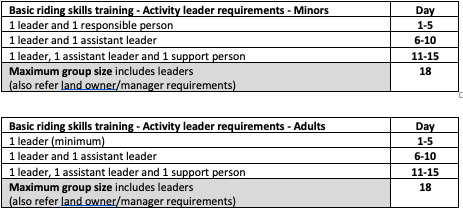
There must be a minimum
of one leader and one responsible person for activities involving minors.
7.5.3 Cycling and cycle touring
The recommended supervision requirements that should be used is provided in the tables below: 
There must be a minimum of one leader and one responsible person for activities involving minors.
7.5.4 Mountain Biking
The recommended supervision requirements that should be used is provided in the tables below: 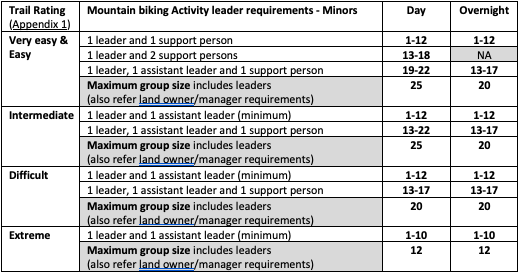
There must be a minimum of one leader and one responsible person for activities involving minors.
There must be a minimum of two activity leaders for trails rated difficult and extreme.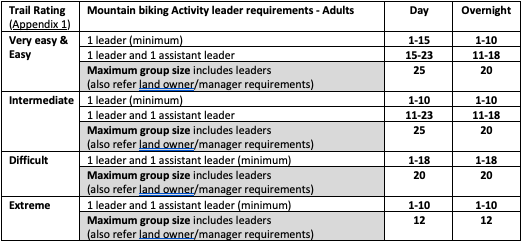
There must be a minimum of two activity leaders for trails rated difficult and extreme.
7.6 Supervision and management during the activity
7.6.1 Cycling supervision and management
Vehicle and road legislation or regulation must be complied with.
The leader of the activity should be familiar with the activity location.
Appropriate risk management procedures must be implemented when using roads shared with motor vehicles.
Participants should be able to easily identify activity leaders (e.g. by having different clothing or helmet colour or design).
Procedures must be used to reduce the potential of participants becoming separated or lost.
7.6.2 Activity briefing
Also refer Core GPG – Activity briefing.
Instruction on the use of the cycle and the activity should include but is not limited to:
- appropriate fitting of helmet including the usage of headwear under the helmet and appropriate method(s) to controlled or style hair
- the use of the brakes, gears and any other adjustable components of the cycle
- correct adjustment of the seat and/or handlebars to maintain a safe and comfortable riding posture
- appropriate emergency braking technique
- safe and appropriate riding techniques appropriate to the expected terrain, current and anticipated conditions to enable the rider to stay in control
- the need to secure loose clothing
- the appropriate distance required between riders
- how the group will avoid becoming separated
- what to do if they become separated from the group or lost
- appropriate interaction with other users
- managing their own health and wellbeing during the activity
- any legal requirements when riding
- procedures for interaction with other vehicles where applicable.
Also refer to the Core Good Practice Guide – Recognition of competencies. [link]
Glossary
Glossary
AAAS: Australian Adventure Activity Standard – See Preface for details.
Bicycle: a type of cycle.
Cycle: a vehicle consisting of wheel(s) held in a frame and propelled by hand or foot by the rider.
Designs may include:
- unicycle
- bicycle
- tricycle
- quad-cycles
- pedelecs.
In addition, cycles may be designed for different conditions including riding:
- on road
- off-road
- in hybrid of conditions
- mountain biking.
Cycles are considered vehicles under vehicle requirements (e.g. road rules, licencing or registration) and land owner or manager requirements (e.g. public land laws or regulations). These requirements may vary based on the jurisdiction it is used.
Cycle-path: a carriageway for cycles designated and defined under law, regulation or land owner/manager requirements of the relevant jurisdiction the activity occurs but excludes trails for mountain biking. Example cycle-paths include shared pathways, foot/bicycle paths, “rail-trails” etc. Also refer to trail and off-road.
E-bikes: cycles equipped with an auxiliary electric motor that can be exclusively propelled by that motor. The cyclist is not necessarily required to pedal.
Flash flooding: is flooding in a localised area with a rapid onset, usually as the result of relatively short intense bursts of rainfall.
GPGs: Good Practice Guide(s) – See Preface for details.
Mountain bikeis a bicycle that has a design for off road use.
Mountain biking is riding a cycle off-road with a major element being the need to negotiate obstacles. This may be either on a trail or a riding surface where there is no indicated path to follow.
Motorcycles a vehicle powered by a motor. Designs may vary and include designed for riding on road, off road and in hybrid of conditions. Motorcycles may also include:
- pedelec or e-bike, where its specifications are deemed to be classified as a motorcycle for vehicle licensing or registration requirements in the jurisdiction it is used,
- tri-motorcycles and
- quad-motorcycles.
Off road: a riding
surface that is not a road or cycle-path. The riding surface is either a trail or a riding surface where there is no
indicated path to follow. Also refer to Cycle-path
and trail.
Obstacles: in relation to:
- mountain biking may include but are not limited to fallen or narrowly spaced trees, tree branches, shallow water crossings, puddles, mud, rocks, steep terrain, depressions, potholes, jumps, logs, ruts, bridges, drainage grates or man-made structures.
- cycling may include but are not limited to bridges, water on road or cycle-paths, bumps, curbs, depressions, pot holes, drainage grates, train lines, parked vehicles or other man-made structures.
Pedelecs: cycles equipped with an auxiliary motor that cannot be exclusively propelled by that motor. Only when the cyclist pedals, does the motor assist.
Power assisted cycle: a type of cycle that can be powered by a motor but is not deemed to be a motorcycle based on vehicle licencing or registration requirements in the jurisdiction it is used. Includes pedelecs and e-bikes.
Road:aformedsealed and unsealed carriageway, that requires vehicles to comply with relevant ‘transport’, vehicle or ‘road’ law or regulation.
Support person: a person with specific competencies but is not equivalent to an Assistant leader in Core GPG.
Support vehicle: a vehicle used to follow or meet a group that can provide any aid or assistance
Trail: an off-road formed riding surface with an indicated path to follow. Trails usually refer to riding surfaces used for mountain bike activities. Also refer to cycle-paths and off-road.
Also refer terms and definitions Core GPG.
Also refer terms and definitions Camping GPG.
Also refer to the Core Good Practice Guide – Glossary.
Appendices
Appendix 1 Mountain bike riding trail rating
International Mountain Bicycling Association (IMBA) Australian Trail Difficulty Rating System.
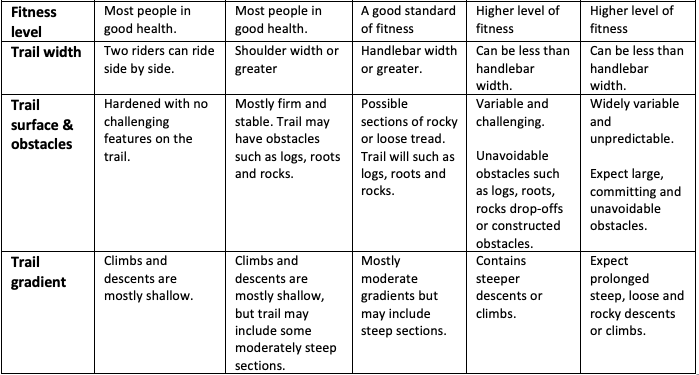
Appendix 2 Equipment lists
Tools
Suggested tools to carry:
- chain breaker
- pliers
- spoke key
- spanners/adjustable spanner
- screwdrivers
- allen key tool
- torx keys
- two tyre levers
- pump with suitable connector(s)
- shock pump.
Additional tools for multi-day trips either with group or via support vehicle:
- headset spanner
- pedal spanner
- crank puller
- pliers with cable cutter
- pressure gauge
- adjustable spanner
- two cone spanners.
Spares
Suggested spares to carry:
- puncture repair kit (glue and patches)
- tube of lubricant
- piece of chain and chain repair components
- inner tubes of appropriate size, with valve stems appropriate for the rims in use
- brake pads appropriate for the brakes in use
- bar end plugs.
Suggested spares to carry on multiday rides:
- brake cable / hydraulic inners
- gear cable inners.
Suggested additional spares for multi-day trips either with the group or via support vehicle:
- front and rear derailleur and hanger appropriate for the bikes in use
- lubricant
- rags
- pedals
- various cable ties
- duct tape
- spare bikes.
Other equipment
The equipment required and the appropriate “type” of equipment used is dependent on the specific context of the activity.
Equipment used for Cycling, Mountain Biking or Cycle Touring may include but is not limited to:
Emergency/rescue
- documentation (see Core GPG – Activity leader required documentation)
- emergency communication equipment (see Core GPG – Emergency communication)
- first aid kit (see Core GPG -First aid equipment and medication) in waterproof storage
- a waterproof method of storing and carrying documentation and communications equipment
- emergency shelter where appropriate for the context
- emergency equipment to keep a patient warm (e.g. mat, sleeping bag) where appropriate for the context.
Activity Leaders
- communications equipment (standard communication rather than emergency communication where this differs) and spare batteries or backup “power banks”
- relevant maps and navigation information
- a waterproof method of storing and carrying maps and navigation information
- compass and/or other navigation aids e.g. GPS
- pen/pencil and blank writing paper
- watch or equipment suitable to tell and measure time for first aid purposes
- head torch and spare batteries
- plus same as for participant (see below).
Group
- trowel for toileting
- toilet paper
- hand sanitiser
- water purification system
- food for duration plus spare
- rubbish bags
- sunscreen
- insect repellent.
Participant
- appropriate clothing
- appropriate footwear
- personal protective equipment (see Use of equipment section)
- personal medications (including for asthma and anaphylaxis)
- sunglasses
- prescription glasses
- high visibility vest
- sunscreen
- water container
- food or snacks.
Additional equipment used for overnight or extended duration mountain biking or cycle touring refer Camping GPG.
Appendix 3 Weather information
The Bureau of Meteorology provides a range of services. For details refer to:
http://www.bom.gov.au/weather-services/WeatherGuideLand.pdf
The following table details the:
- current Australian weather warnings
- associated weather for each warning
- mainland warning trigger points for issuing warnings for strong winds and hail.
Bureau of Meteorology weather warnings and associated weather Table: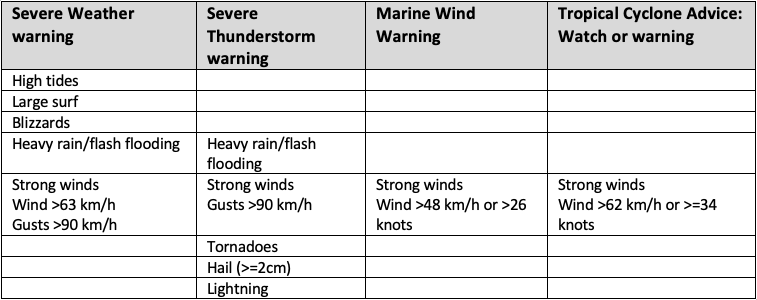
Appendix 4 Leader competencies
Also refer to competencies section in Core GPG.
A4.1 Cycling support person
The minimum competencies recommended to provide appropriate activity leadership as a support person are: 
A4.2 Cycling basic riding skills training competencies
Basic riding skills training is teaching participants to ride a cycle.
The minimum competencies recommended are: 
A4.3 Cycling guide competencies
All activity leaders must have the appropriate competencies for the context of the activity, as listed in the various units of training (or the unit’s equivalent), listed in the following table.
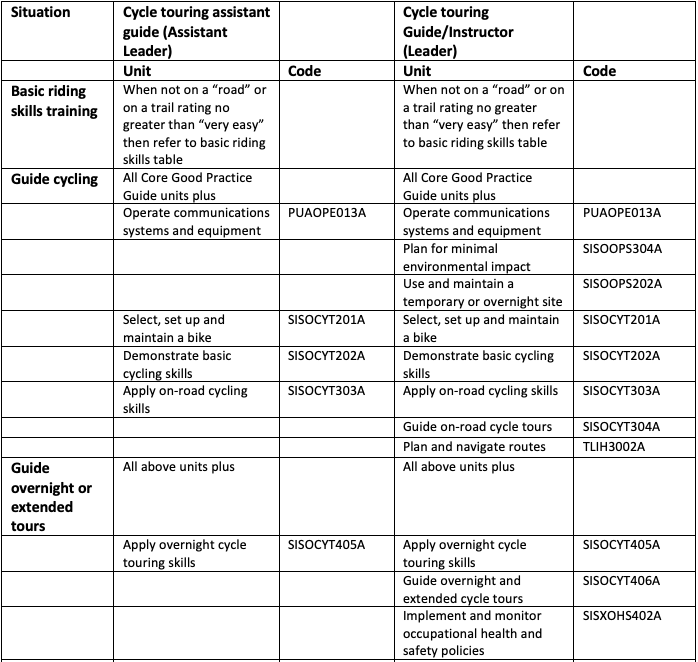

Instruct cycling touring
refers to instruction with the aim of enable participants to achieve the skills
and knowledge required to participate independently. This differs from guiding
and general ‘instruction’ that might be given to enable the participant to do
the activity but only under supervision of an activity leader.
A4.4 Mountain Biking competencies
All activity leaders must have the appropriate competencies for the context of the activity, as listed in the units of training (or a unit’s equivalent), listed in the following table.
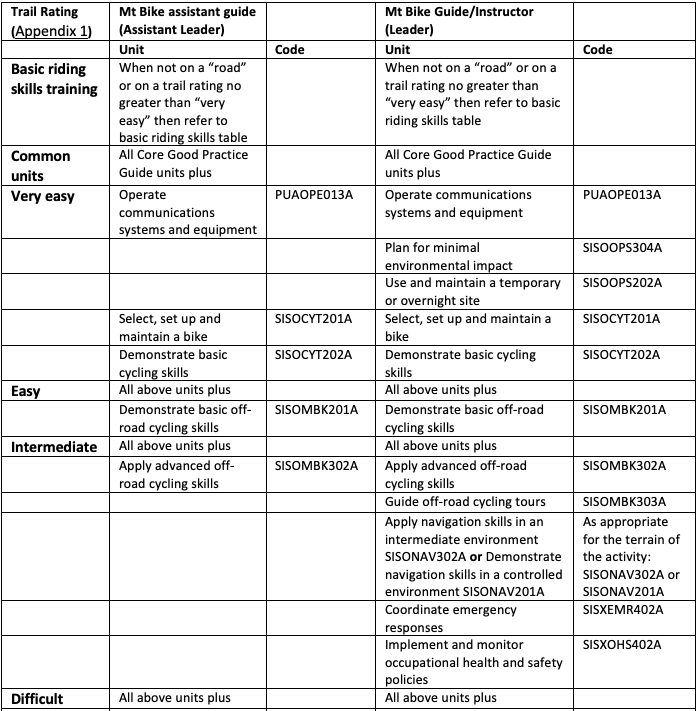
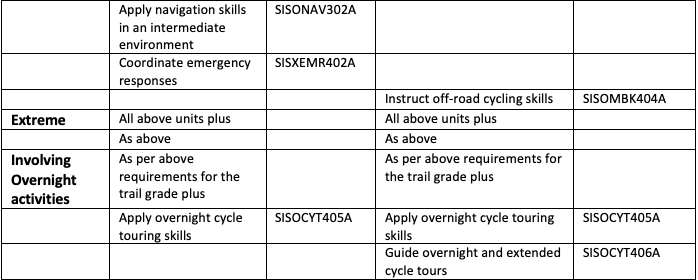
Instruct mountain biking refers to instruction with the aim of enable participants to achieve the skills and knowledge required to participate independently. This differs from guiding and general ‘instruction’ that might be given to enable the participant to do the activity but only under supervision of an activity leader.
